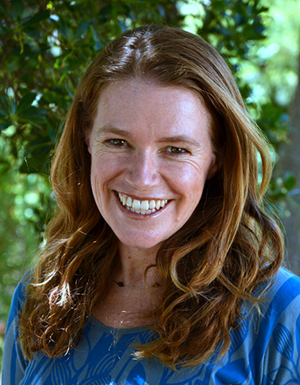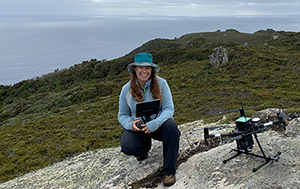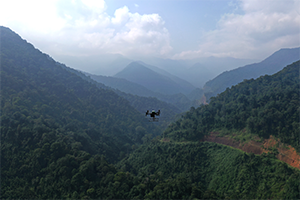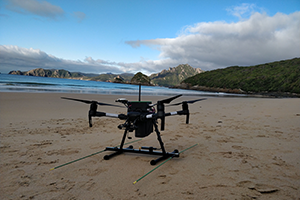 What started off as a grant-funded research project for ecologist Dr Debbie Saunders, has turned into Wildlife Drones, a company providing world-leading radio-tracking drone systems.
What started off as a grant-funded research project for ecologist Dr Debbie Saunders, has turned into Wildlife Drones, a company providing world-leading radio-tracking drone systems.
Like most startups, the idea started many years ago with a problem that needed solving. Debbie was studying the movements of the Swift Parrot, a small critically endangered bird that migrates between Tasmania and mainland Australia. One of the biggest challenges facing conservationists tracking endangered animals is that they have to manually track one animal at a time, on foot and very often in rugged and remote terrain. This limits the number of animals that can be monitored.
Debbie was talking with a colleague who researched lions.
“We both were wildlife researchers and wanted to find better ways of tracking animals. He suggested drones and that sowed a seed in my mind,” says Debbie.
“In 2011 I managed to get a research project up in collaboration with Sydney University because they had a field robotics centre and were one of the few places in Australia that used drones at the time.”
“It was the first time in the world that anyone had ever radio-tracked from a drone, so we wanted to do a small demo project here in Canberra at Mulligan's flat. We had demonstrated that the technology worked tracking woodland birds at our field site, and then lined up an experimental project with people on the ground and the drone to showcase our technology.
“It was an absolute disaster because we discovered our prototype was susceptible to radio interference which we hadn't experienced at any of our field testing sites until that point.
“We identified these weaknesses in the system, essentially right at the end of the project. But the media had seen our published research and knew the system worked, so we went ahead as we were still the first in the world to do it. We received a lot of media coverage and that changed everything,” says Debbie.
“I had never really been on social media, but it just went crazy on Twitter. I had people from all around the world contacting me asking how they could get one of the things!”
 Look outside your immediate circle
Look outside your immediate circle
Debbie decided to explore new options after the project and decided to look at the innovation ecosystem beyond the university environment.
“The very first thing I did was go to a women's leadership conference. I had never been to one before but it was amazing. I saw a whole bunch of inspiring women and I went on a mission to meet people in the innovation space, and set about educating myself in what it takes to identify a market need and to translate a research prototype into a user-friendly product that overcame the challenges previously identified. We received an InnovationACT grant and then we received an ACT Government Innovation Connect grant.
“Each of the grants has been key in their own right. Innovation ACT enabled us to pay a lawyer and get our first agreements written, and then the Innovation Connect grant allowed us to buy a drone for the first time and have our own system to demonstrate market traction.
“At each step, we would say ‘if we get this grant, we'll keep going’ or ‘if we get some customers, we'll keep going’. We just kept being successful, so we kept going”.
Opportunities can come from unexpected places
The journey to raising over $670,000 in seed funding has had some unexpected surprises for Wildlife Drones.
“I tried all the usual channels,” says Debbie. “So, going through organisations like Capital Angels, a pitch to Uniseed up in Sydney, a venture capital firm etc. However, in the end, the majority of my investment came from somebody I met on LinkedIn. I didn’t even know he was an investor! He said he came to Canberra often and I said I was happy to meet up and talk about it. When I explained the business and showed him the pitch deck, he said he was actually interested in investing.”
Debbie says it still blows her away that people can believe in her ideas and passion so much that they will invest money for her to give it a go and see if she can make this work.
The impact of COVID-19
 Debbie says that a number of customers have now been lost given their funding cuts due to the coronavirus pandemic, and other projects have been delayed.
Debbie says that a number of customers have now been lost given their funding cuts due to the coronavirus pandemic, and other projects have been delayed.
“We didn't distribute any of our systems during the pandemic lockdown, but we did have customers who already had our system and were using it. There was just a bit of a pause on getting stuff out. But we used the time to focus on manufacturing and building systems as well as marketing and getting our messaging right,” says Debbie.
Wildlife Drones has been getting international enquiries even with all the lockdowns. Debbie thinks that this might be due to people having more time to look at what options are out there and think about things a bit differently, and the fact that she has presented at numerous international conferences over the past six months with more opportunities to connect with targeted audiences than ever before.
“In one week, we had enquiries from Colombia, Scandinavia, South Africa and Malaysia about wildlife conservation projects and endangered species that they want to track,” says Debbie.
Wildlife Drones’ product consists of a radio-receiver system that fits into a small pelican case and can be couriered anywhere in the world.
“We can also do a virtual demo online and show the pilot the interface and how it works and then they go off and do it, no matter where they are in the world”.
“Unlike every other hire company, when you hire it, you're left to your own devices. We actually provide full support. For example, we have just sent a system over to Western Australia to track bandicoots. They've got one big sand dune where they can get reception, so the pilot goes up onto the sand dune and gives us a call and we can help him with some troubleshooting and give him some work arounds if he needs it.
“The data is analyzed in real time, so there's no post-processing required. However, there's always something to nuance for a particular site. You get points on a map and an error estimate around it. All the analytics are done in real time so there's none of that going back to the office and having to look at what's happened”. Debbie says that Wildlife Drones’ technology doesn’t need any internet connectivity to work in the field so it’s perfect for those working in remote landscapes.
Debbie says that Wildlife Drones’ technology doesn’t need any internet connectivity to work in the field so it’s perfect for those working in remote landscapes.
“But if they're having an issue and can get to a location where they have some internet connectivity, we can actually log into their machine and control it and fix things and update things. We are able to support people anywhere in the world.
“We have recently received certification for compliance testing of our electronics, including emissions and things like that. We've got US and Australian certified radio comms in those systems, so that opens up the US market, as well as other countries where FCC certification is accepted such as throughout South America.”.
Debbie says that during the corona crisis Wildlife Drones has also diversified.
“It's not really related to COVID at all, but it's just that we keep getting enquiries from koala researchers to do thermal imagery. I've never done anything with imagery, but when we recently employed new pilots all of a sudden that became a possibility. They have the qualifications and experience to do that. So, we've been exploring and testing out thermal camera technology, which I think is highly complementary to the radio tracking. Often people want to do thermal imaging to catch the animals so they can tag them, and then they'll be able to use a radio tracking system. I’m also looking at the invasive species space using this combination of radio tracking and thermal.
Wildlife Drones is setting new standards in wildlife monitoring and the tracking of small animals in remote wilderness areas using their cutting-edge technology. This will allow conservationists and research teams to track more animals at the same time, aiding in rehabilitation programs around the world.
An initiative of the ACT Chief Minister’s Export Awards
The ACT Chief Minister’s Export Awards aims to showcase and celebrate the achievements of Canberra region exporting businesses. These Canberra and region businesses transact significant parts of their business activities (legal, accounting, production, research etc.) through the ACT as they develop international markets. The ACT Chief Minister’s Export Awards aims to build the pathway for new and emerging Canberra region businesses seeking to internationalise their business. If you are a new or existing exporting businesses in the Canberra region, you can access a range of support as well as network with other exporting businesses, including
The ACT TradeStart Program helps ACT exporters to achieve long term success in international markets. The TradeStart program allows the ACT Government to work closely with Austrade and access key Austrade resources such as their export database, trade mission activities, their off-shore offices, intelligence and international connections for the trade and investment activities to support ACT exporters.
The International Business Engagement Program is being delivered by Canberra Business Chamber on behalf of the ACT Government. Its main objective is to maintain, rebuild and find new opportunities for Canberra and region businesses to engage internationally. The program focuses on building the Territory’s exporting community; providing training and support by facilitating seminars and workshops; creating links between local industry and other government support programs; assisting the ACT Government in co-ordination of business trade delegations (outbound and inbound).


